University Company Accounting Assignment: ACCT20073, Term 2 2019
VerifiedAdded on 2022/10/02
|8
|1436
|18
Homework Assignment
AI Summary
This document presents a comprehensive solution to a company accounting assignment, addressing key concepts such as fair value measurement under IFRS 13, depreciation methods, and impairment testing. The assignment explores the valuation of assets and liabilities, emphasizing the importance of fair value in reflecting a company's true financial position. It delves into the differences between fair value and historical cost, analyzing the reasons why managers might prefer the cost model. The solution further examines impairment tests, detailing the process of identifying cash-generating units and assessing the recoverable amount of assets. The analysis includes practical examples and references to relevant accounting standards and literature, providing a thorough understanding of the subject matter. This assignment is designed to help students understand and apply accounting principles to real-world scenarios, offering a valuable resource for those studying company accounting.
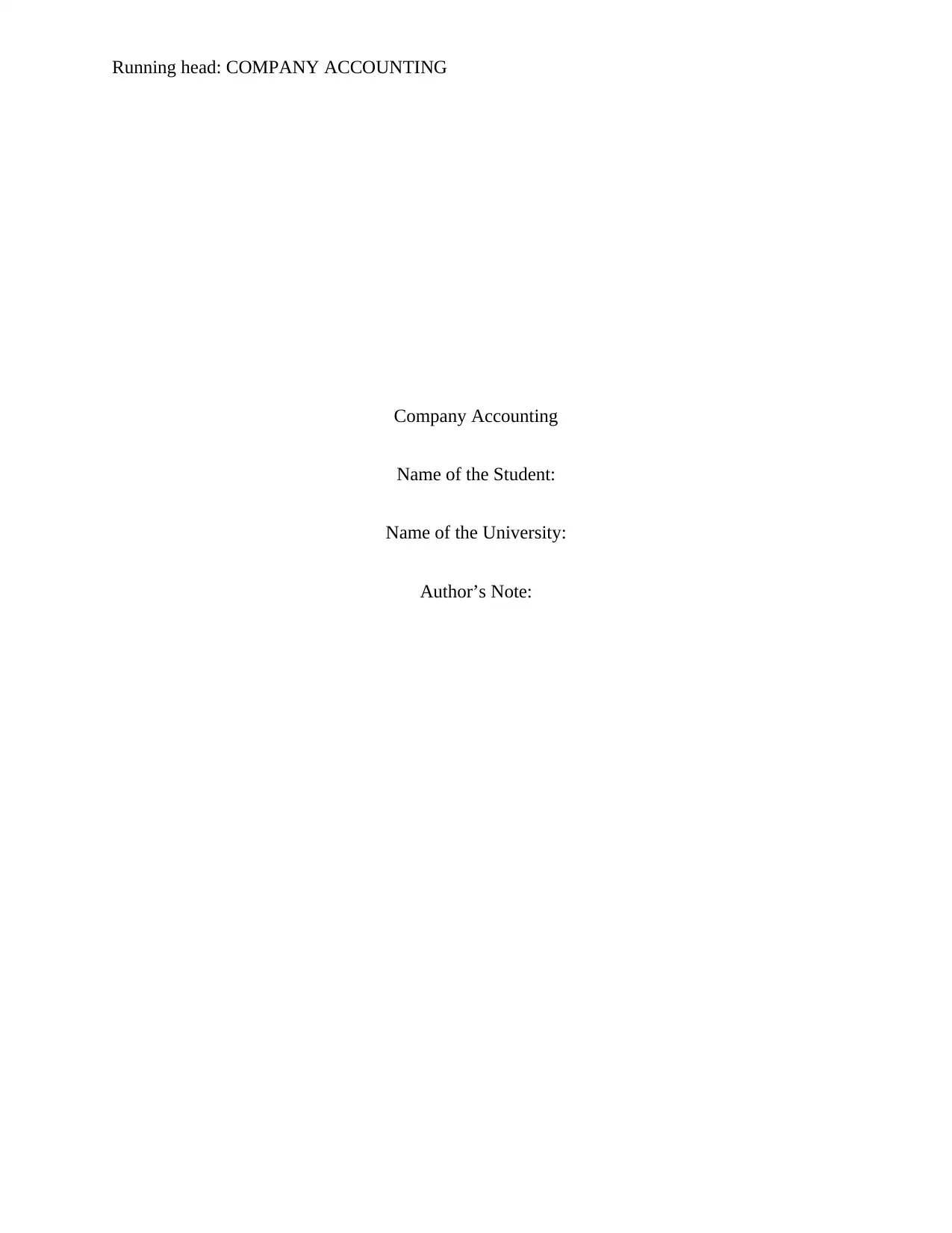
Running head: COMPANY ACCOUNTING
Company Accounting
Name of the Student:
Name of the University:
Author’s Note:
Company Accounting
Name of the Student:
Name of the University:
Author’s Note:
Paraphrase This Document
Need a fresh take? Get an instant paraphrase of this document with our AI Paraphraser
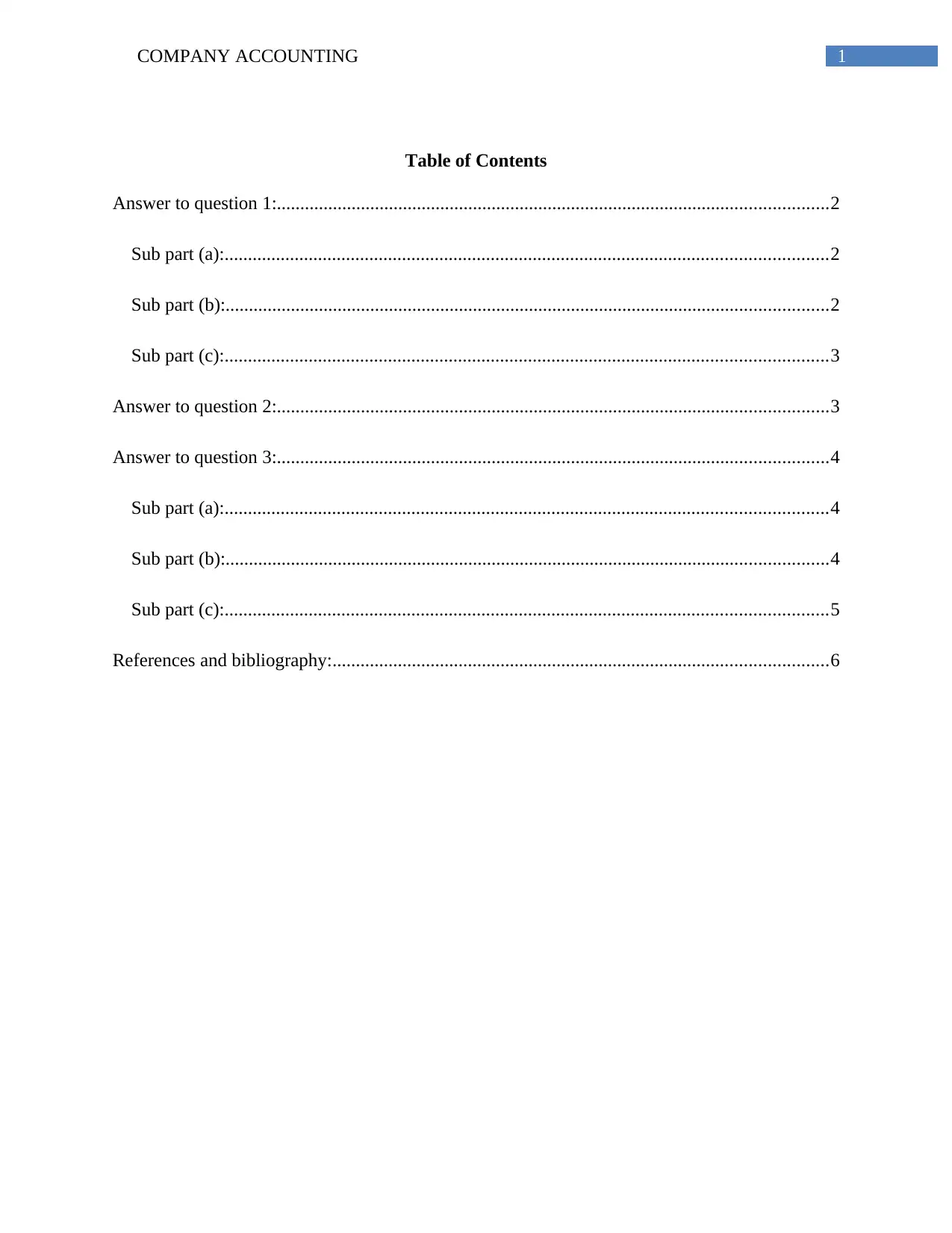
1COMPANY ACCOUNTING
Table of Contents
Answer to question 1:......................................................................................................................2
Sub part (a):.................................................................................................................................2
Sub part (b):.................................................................................................................................2
Sub part (c):.................................................................................................................................3
Answer to question 2:......................................................................................................................3
Answer to question 3:......................................................................................................................4
Sub part (a):.................................................................................................................................4
Sub part (b):.................................................................................................................................4
Sub part (c):.................................................................................................................................5
References and bibliography:..........................................................................................................6
Table of Contents
Answer to question 1:......................................................................................................................2
Sub part (a):.................................................................................................................................2
Sub part (b):.................................................................................................................................2
Sub part (c):.................................................................................................................................3
Answer to question 2:......................................................................................................................3
Answer to question 3:......................................................................................................................4
Sub part (a):.................................................................................................................................4
Sub part (b):.................................................................................................................................4
Sub part (c):.................................................................................................................................5
References and bibliography:..........................................................................................................6

2COMPANY ACCOUNTING
Answer to question 1:
Sub part (a):
Each company should able to value their asset and liability as per the fair value in the
market, as IFRS 13 state that it should be recorded in net realizable value so that the investor can
know the original value of the company, while considering it company should also take into
consideration the assumption of market participants (Aasb.gov.au. 2019). Company is able to
take new asset than it should to consider the best quoted price of the asset. It also shows about
different market but it do not conclude upon a single market participants.
Sub part (b):
Fair value is a measurement which uses market as its base and not a measurement
which is entity-specific. Some market data or market transactions which are observable may be
accessible for assets and liabilities. The aim of a fair value measurement is same for both the
situations- to guesstimate the cost at which a transaction are present (Sarker, Dvorkin & Ortega-
Vazquez,2015). Being a measurement that is measurement based, fair value is calculated by
utilizing the norms that the market-based measurement, by utilizing the norms, which market
contestants would use while setting the price of the asset or liability, it also includes norms about
risk. Therefore, the purpose of an entity is to hold an asset or to settle or else achieve a liability
that is not in relevance while measuring the fair value (Beekes etal., 2016).
Answer to question 1:
Sub part (a):
Each company should able to value their asset and liability as per the fair value in the
market, as IFRS 13 state that it should be recorded in net realizable value so that the investor can
know the original value of the company, while considering it company should also take into
consideration the assumption of market participants (Aasb.gov.au. 2019). Company is able to
take new asset than it should to consider the best quoted price of the asset. It also shows about
different market but it do not conclude upon a single market participants.
Sub part (b):
Fair value is a measurement which uses market as its base and not a measurement
which is entity-specific. Some market data or market transactions which are observable may be
accessible for assets and liabilities. The aim of a fair value measurement is same for both the
situations- to guesstimate the cost at which a transaction are present (Sarker, Dvorkin & Ortega-
Vazquez,2015). Being a measurement that is measurement based, fair value is calculated by
utilizing the norms that the market-based measurement, by utilizing the norms, which market
contestants would use while setting the price of the asset or liability, it also includes norms about
risk. Therefore, the purpose of an entity is to hold an asset or to settle or else achieve a liability
that is not in relevance while measuring the fair value (Beekes etal., 2016).
⊘ This is a preview!⊘
Do you want full access?
Subscribe today to unlock all pages.

Trusted by 1+ million students worldwide
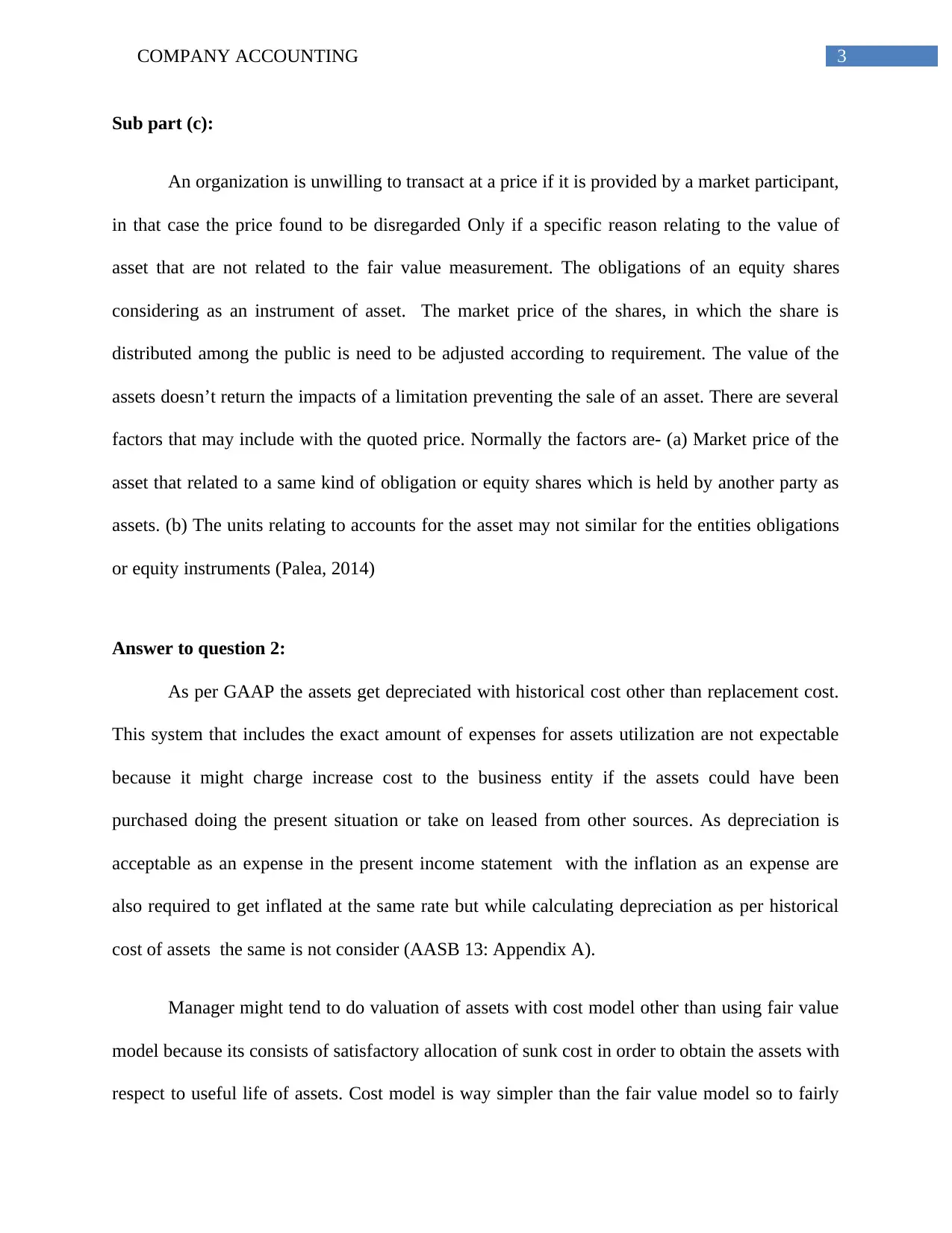
3COMPANY ACCOUNTING
Sub part (c):
An organization is unwilling to transact at a price if it is provided by a market participant,
in that case the price found to be disregarded Only if a specific reason relating to the value of
asset that are not related to the fair value measurement. The obligations of an equity shares
considering as an instrument of asset. The market price of the shares, in which the share is
distributed among the public is need to be adjusted according to requirement. The value of the
assets doesn’t return the impacts of a limitation preventing the sale of an asset. There are several
factors that may include with the quoted price. Normally the factors are- (a) Market price of the
asset that related to a same kind of obligation or equity shares which is held by another party as
assets. (b) The units relating to accounts for the asset may not similar for the entities obligations
or equity instruments (Palea, 2014)
Answer to question 2:
As per GAAP the assets get depreciated with historical cost other than replacement cost.
This system that includes the exact amount of expenses for assets utilization are not expectable
because it might charge increase cost to the business entity if the assets could have been
purchased doing the present situation or take on leased from other sources. As depreciation is
acceptable as an expense in the present income statement with the inflation as an expense are
also required to get inflated at the same rate but while calculating depreciation as per historical
cost of assets the same is not consider (AASB 13: Appendix A).
Manager might tend to do valuation of assets with cost model other than using fair value
model because its consists of satisfactory allocation of sunk cost in order to obtain the assets with
respect to useful life of assets. Cost model is way simpler than the fair value model so to fairly
Sub part (c):
An organization is unwilling to transact at a price if it is provided by a market participant,
in that case the price found to be disregarded Only if a specific reason relating to the value of
asset that are not related to the fair value measurement. The obligations of an equity shares
considering as an instrument of asset. The market price of the shares, in which the share is
distributed among the public is need to be adjusted according to requirement. The value of the
assets doesn’t return the impacts of a limitation preventing the sale of an asset. There are several
factors that may include with the quoted price. Normally the factors are- (a) Market price of the
asset that related to a same kind of obligation or equity shares which is held by another party as
assets. (b) The units relating to accounts for the asset may not similar for the entities obligations
or equity instruments (Palea, 2014)
Answer to question 2:
As per GAAP the assets get depreciated with historical cost other than replacement cost.
This system that includes the exact amount of expenses for assets utilization are not expectable
because it might charge increase cost to the business entity if the assets could have been
purchased doing the present situation or take on leased from other sources. As depreciation is
acceptable as an expense in the present income statement with the inflation as an expense are
also required to get inflated at the same rate but while calculating depreciation as per historical
cost of assets the same is not consider (AASB 13: Appendix A).
Manager might tend to do valuation of assets with cost model other than using fair value
model because its consists of satisfactory allocation of sunk cost in order to obtain the assets with
respect to useful life of assets. Cost model is way simpler than the fair value model so to fairly
Paraphrase This Document
Need a fresh take? Get an instant paraphrase of this document with our AI Paraphraser
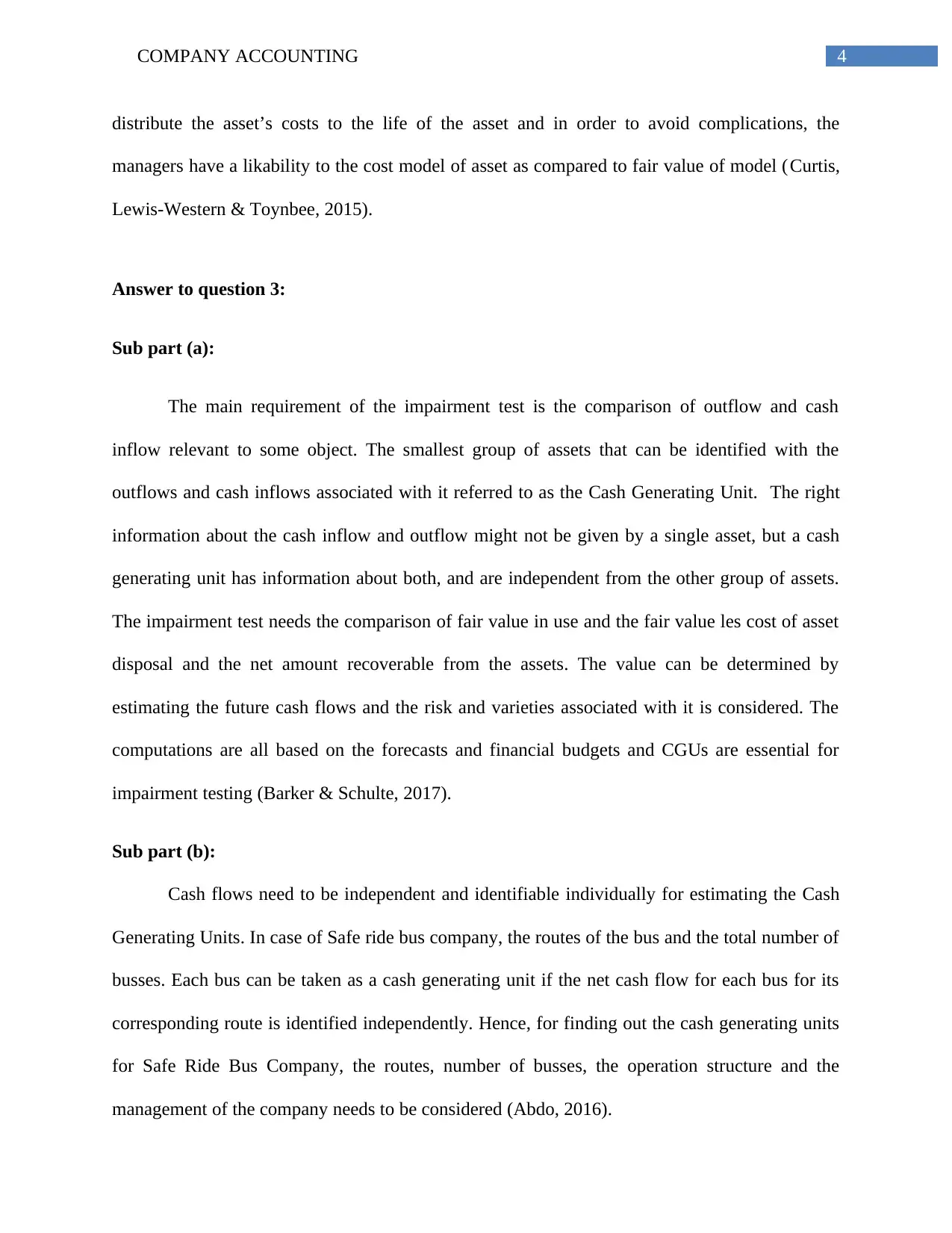
4COMPANY ACCOUNTING
distribute the asset’s costs to the life of the asset and in order to avoid complications, the
managers have a likability to the cost model of asset as compared to fair value of model (Curtis,
Lewis-Western & Toynbee, 2015).
Answer to question 3:
Sub part (a):
The main requirement of the impairment test is the comparison of outflow and cash
inflow relevant to some object. The smallest group of assets that can be identified with the
outflows and cash inflows associated with it referred to as the Cash Generating Unit. The right
information about the cash inflow and outflow might not be given by a single asset, but a cash
generating unit has information about both, and are independent from the other group of assets.
The impairment test needs the comparison of fair value in use and the fair value les cost of asset
disposal and the net amount recoverable from the assets. The value can be determined by
estimating the future cash flows and the risk and varieties associated with it is considered. The
computations are all based on the forecasts and financial budgets and CGUs are essential for
impairment testing (Barker & Schulte, 2017).
Sub part (b):
Cash flows need to be independent and identifiable individually for estimating the Cash
Generating Units. In case of Safe ride bus company, the routes of the bus and the total number of
busses. Each bus can be taken as a cash generating unit if the net cash flow for each bus for its
corresponding route is identified independently. Hence, for finding out the cash generating units
for Safe Ride Bus Company, the routes, number of busses, the operation structure and the
management of the company needs to be considered (Abdo, 2016).
distribute the asset’s costs to the life of the asset and in order to avoid complications, the
managers have a likability to the cost model of asset as compared to fair value of model (Curtis,
Lewis-Western & Toynbee, 2015).
Answer to question 3:
Sub part (a):
The main requirement of the impairment test is the comparison of outflow and cash
inflow relevant to some object. The smallest group of assets that can be identified with the
outflows and cash inflows associated with it referred to as the Cash Generating Unit. The right
information about the cash inflow and outflow might not be given by a single asset, but a cash
generating unit has information about both, and are independent from the other group of assets.
The impairment test needs the comparison of fair value in use and the fair value les cost of asset
disposal and the net amount recoverable from the assets. The value can be determined by
estimating the future cash flows and the risk and varieties associated with it is considered. The
computations are all based on the forecasts and financial budgets and CGUs are essential for
impairment testing (Barker & Schulte, 2017).
Sub part (b):
Cash flows need to be independent and identifiable individually for estimating the Cash
Generating Units. In case of Safe ride bus company, the routes of the bus and the total number of
busses. Each bus can be taken as a cash generating unit if the net cash flow for each bus for its
corresponding route is identified independently. Hence, for finding out the cash generating units
for Safe Ride Bus Company, the routes, number of busses, the operation structure and the
management of the company needs to be considered (Abdo, 2016).
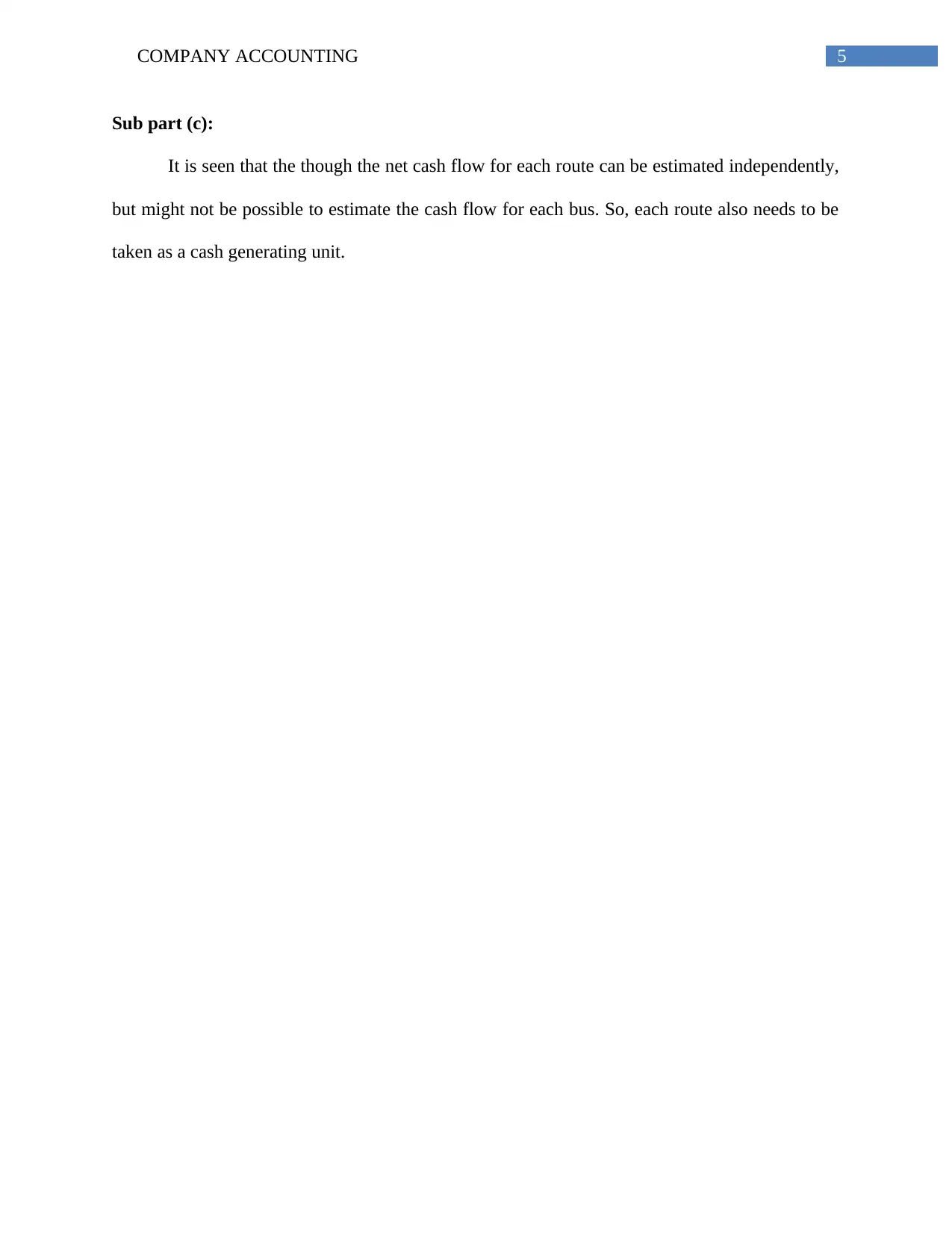
5COMPANY ACCOUNTING
Sub part (c):
It is seen that the though the net cash flow for each route can be estimated independently,
but might not be possible to estimate the cash flow for each bus. So, each route also needs to be
taken as a cash generating unit.
Sub part (c):
It is seen that the though the net cash flow for each route can be estimated independently,
but might not be possible to estimate the cash flow for each bus. So, each route also needs to be
taken as a cash generating unit.
⊘ This is a preview!⊘
Do you want full access?
Subscribe today to unlock all pages.

Trusted by 1+ million students worldwide

6COMPANY ACCOUNTING
References and bibliography:
Aasb.gov.au. (2019). Retrieved 13 August 2019, from
https://www.aasb.gov.au/admin/file/content105/c9/AASB13_08-15.pdf
Abdo, H. (2016). Accounting for Extractive Industries: Has IFRS 6 Harmonised Accounting
Practices by Extractive Industries?. Australian Accounting Review, 26(4), 346-359.
Barker, R., & Schulte, S. (2017). Representing the market perspective: Fair value measurement
for non-financial assets. Accounting, Organizations and Society, 56, 55-67.
Beekes, W., Brown, P. R., Chin, G., & Zhang, Q. (2016). The effects of corporate governance on
information disclosure, timeliness and market participants’ expectations. Timeliness and
Market Participants’ Expectations (June 1, 2016).
Bugeja, M., Czernkowski, R., & Moran, D. (2015). The impact of the management approach on
segment reporting. Journal of Business Finance & Accounting, 42(3-4), 310-366.
Curtis, A., Lewis-Western, M. F., & Toynbee, S. (2015). Historical cost measurement and the
use of DuPont analysis by market participants. Review of Accounting Studies, 20(3),
1210-1245.
Dawidowicz, A., Radzewicz, A., & Renigier-Biłozor, M. (2014). Algorithm for purposes of
determining real estate markets efficiency with help of land administration system.
Survey review, 46(336), 189-204.
Palea, V. (2014). Fair value accounting and its usefulness to financial statement users. Journal of
Financial Reporting and Accounting, 12(2), 102-116.
References and bibliography:
Aasb.gov.au. (2019). Retrieved 13 August 2019, from
https://www.aasb.gov.au/admin/file/content105/c9/AASB13_08-15.pdf
Abdo, H. (2016). Accounting for Extractive Industries: Has IFRS 6 Harmonised Accounting
Practices by Extractive Industries?. Australian Accounting Review, 26(4), 346-359.
Barker, R., & Schulte, S. (2017). Representing the market perspective: Fair value measurement
for non-financial assets. Accounting, Organizations and Society, 56, 55-67.
Beekes, W., Brown, P. R., Chin, G., & Zhang, Q. (2016). The effects of corporate governance on
information disclosure, timeliness and market participants’ expectations. Timeliness and
Market Participants’ Expectations (June 1, 2016).
Bugeja, M., Czernkowski, R., & Moran, D. (2015). The impact of the management approach on
segment reporting. Journal of Business Finance & Accounting, 42(3-4), 310-366.
Curtis, A., Lewis-Western, M. F., & Toynbee, S. (2015). Historical cost measurement and the
use of DuPont analysis by market participants. Review of Accounting Studies, 20(3),
1210-1245.
Dawidowicz, A., Radzewicz, A., & Renigier-Biłozor, M. (2014). Algorithm for purposes of
determining real estate markets efficiency with help of land administration system.
Survey review, 46(336), 189-204.
Palea, V. (2014). Fair value accounting and its usefulness to financial statement users. Journal of
Financial Reporting and Accounting, 12(2), 102-116.
Paraphrase This Document
Need a fresh take? Get an instant paraphrase of this document with our AI Paraphraser

7COMPANY ACCOUNTING
Sarker, M. R., Dvorkin, Y., & Ortega-Vazquez, M. A. (2015). Optimal participation of an
electric vehicle aggregator in day-ahead energy and reserve markets. IEEE Transactions
on Power Systems, 31(5), 3506-3515.
Sarker, M. R., Dvorkin, Y., & Ortega-Vazquez, M. A. (2015). Optimal participation of an
electric vehicle aggregator in day-ahead energy and reserve markets. IEEE Transactions
on Power Systems, 31(5), 3506-3515.
1 out of 8
Related Documents
Your All-in-One AI-Powered Toolkit for Academic Success.
+13062052269
info@desklib.com
Available 24*7 on WhatsApp / Email
![[object Object]](/_next/static/media/star-bottom.7253800d.svg)
Unlock your academic potential
Copyright © 2020–2025 A2Z Services. All Rights Reserved. Developed and managed by ZUCOL.





